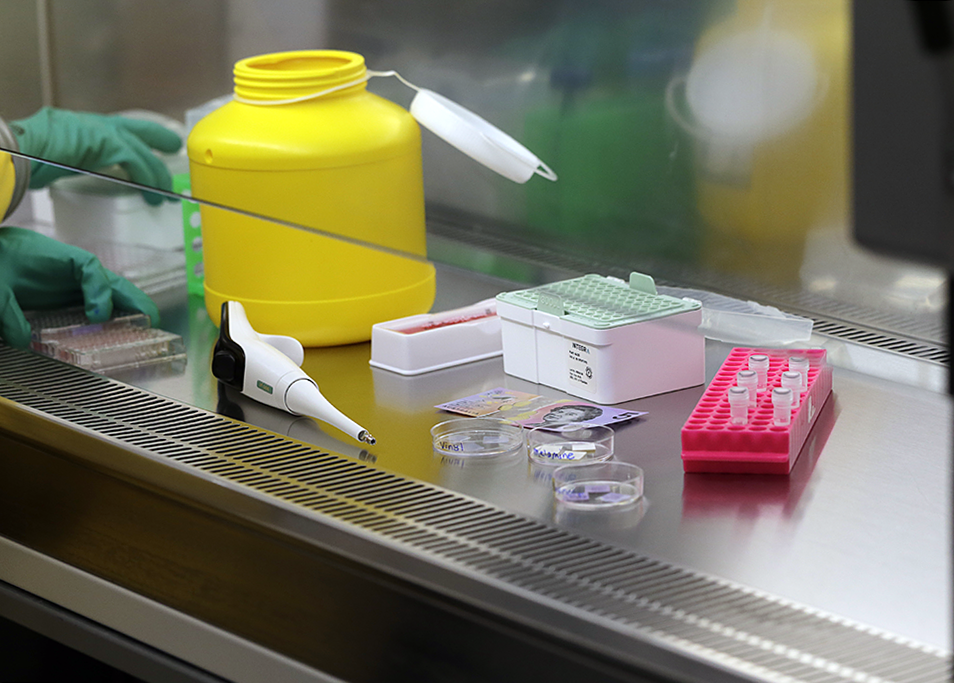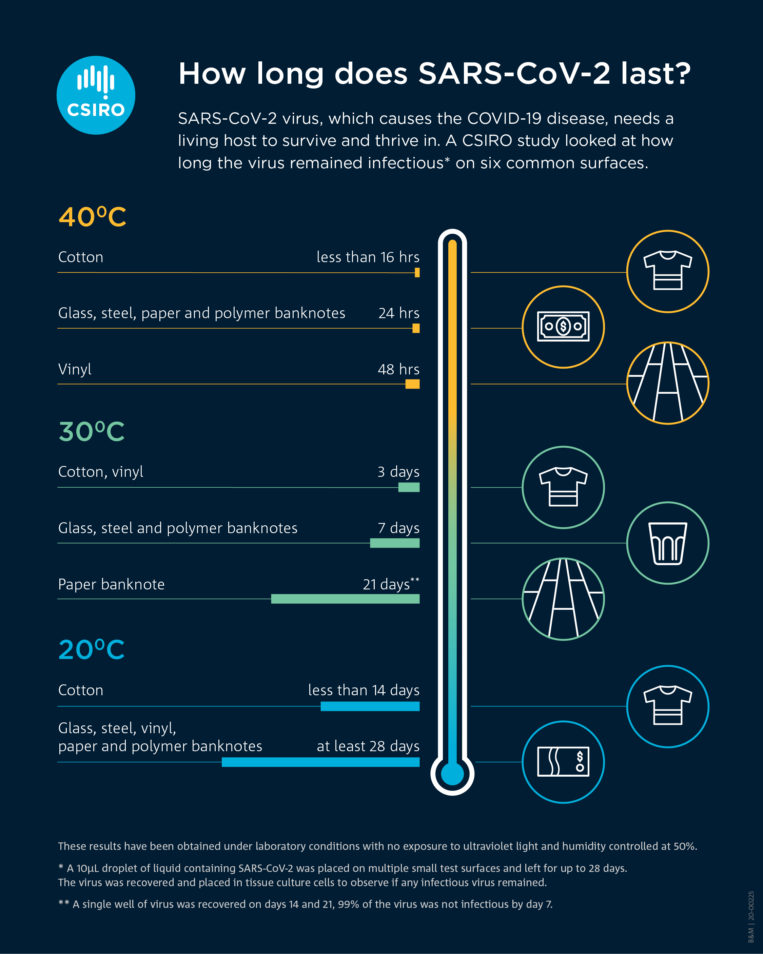Global S&T Development Trend Analysis Platform of Resources and Environment
| COVID-19 causing virus can survive 28 days on surfaces | |
| admin | |
| 2020-10-12 | |
| 发布年 | 2020 |
| 语种 | 英语 |
| 国家 | 澳大利亚 |
| 领域 | 地球科学 |
| 正文(英文) |  Our COVID-19 research includes SARS-CoV-2 on surfaces. We’re conducting the work within our highly secure Biosecurity Level 4 laboratories at the Australian Centre for Disease Preparedness (ACDP). From the moment you turn off your morning alarm, to the time you hit the pillow, your life is full of surfaces. Swiping through your phone, opening doors, putting in your PIN – there are many you don’t think twice about touching. But SARS-CoV-2, the virus that causes COVID-19, will likely change the way we all think about, and interact with, surfaces forever. Our peer-reviewed study published in Virology Journal reveals new information about the virus and how it behaves on surfaces. Understanding SARS-CoV-2 on surfacesFrom analysing sewage to testing face masks, our research has been contributing to the global battle against COVID-19. At this stage of the pandemic, researchers do not fully understand the role contaminated surfaces play in the transmission of SARS-CoV-2. To improve our understanding of how this new virus behaves, our researchers studied the survival rates of infectious SARS-CoV-2, dried in an artificial mucous solution, on six common surfaces. We conducted the experiment at three different temperatures, 200C, 300C and 400C, with the relative humidity kept at 50 per cent. The surfaces used in the study were stainless steel, glass, vinyl, paper and polymer banknotes, and cotton cloth. These are examples of high contact surface areas such as glass on touchscreens and stainless steel doorknobs. A droplet of fluid containing the virus at concentrations similar to levels observed in infected patients was dried on multiple small test surfaces and left for up to 28 days. At various time periods, the virus was recovered and placed in tissue culture cells to observe if any infectious virus remained. Impact of temperature on virusAt 20°C, the virus was extremely robust. We were able to recover infectious material after 28 days from the smooth (non-porous) surfaces. These are stainless steel, glass, vinyl and paper and polymer banknotes. The length of time infectious virus was able to survive on the porous material (cotton cloth) was much shorter. On cloth, we were unable to detect any viable virus past 14 days. At 30°C infectious virus did not survive beyond seven days on stainless steel, money (polymer banknotes) and glass. However, on vinyl and cotton cloth, infectious material was not detectable beyond three days. At 40°C virus was inactivated much faster. Infectious SARS-CoV-2 was detectable for less than 16 hours for cotton cloth. While on glass, paper and polymer notes, and stainless steel it was detectable for up to 24 hours, and 48 hours for vinyl.  How long SARS-CoV-2 survived on five different surfaces at three temperatures, 20°C, 30°C and 40°C. How many particles can cause an infection?It generally takes more than one virus particle to infect a person and make them sick. We call the number of virus particles that can cause infection the “infectious dose”. This dosage differs between different viruses and is usually quite large. Researchers do not yet know the infectious dose of SARS-CoV-2. But, from our knowledge of related viruses, we estimate it is around 300 particles. If the virus was placed (on smooth surfaces) at standard mucus concentrations of an infected person, enough virus would easily survive for two weeks to be able to infect another person. Further research on this topic is necessary. However, our findings indicate the 28-day sample would not contain enough viable virus to infect a person. Whether virus particles on a surface can infect someone is dependent on several conditions. Outside of the body, SARS-CoV-2 virus particles gradually become inactive over time. The time it takes for viruses to naturally inactivate depends on many factors. The makeup of the virus itself, the type of surface it is on and whether the virus is liquid or dried can impact the time it remains viable. Environmental conditions such as temperature, exposure to sunlight and humidity also play a part. Cash or card? A droplet of liquid containing the SARS-CoV-2 virus on a $5 note. How virus transmission worksIn general, we know people deposit viruses onto surfaces by coughing or sneezing. They are also readily transferred between contaminated skin and surfaces. The results from our study confirm that high-contact surfaces may pose a risk. These are the type of surfaces that have a significant number of different people touching them each day. They include bank ATMs, handrails, door handles, elevator buttons, supermarket self-serve check-outs and money. While we can’t yet answer the likelihood of developing COVID-19 from surfaces, we do know the SARS-CoV-2 virus can’t penetrate skin. To catch the disease, you would first need to introduce the virus into your mouth, nose or eyes. Our findings reinforce the message that you should avoid touching our eyes, nose and mouth and keep washing your hands. It’s also important to be careful when removing facemasks as the virus can survive on the outside where you could transfer it to your hands. Building our understanding of COVID-19Although we still don’t know how much virus it takes to infect someone, our research is forming a better understanding of how this new virus behaves. Our knowledge that the virus survives longer at colder temperatures may also help to explain the spread of SARS-CoV-2 in environments such as meat processing facilities. Our research will help to provide insight into the risks associated with COVID-19. And can help with the development of procedures for minimising the chances of virus spread via surfaces. |
| URL | 查看原文 |
| 来源平台 | Commonwealth Scientific and Industrial Research Organisation |
| 文献类型 | 新闻 |
| 条目标识符 | http://119.78.100.173/C666/handle/2XK7JSWQ/297647 |
| 专题 | 地球科学 |
| 推荐引用方式 GB/T 7714 | admin. COVID-19 causing virus can survive 28 days on surfaces. 2020. |
| 条目包含的文件 | 条目无相关文件。 | |||||
| 个性服务 |
| 推荐该条目 |
| 保存到收藏夹 |
| 查看访问统计 |
| 导出为Endnote文件 |
| 谷歌学术 |
| 谷歌学术中相似的文章 |
| [admin]的文章 |
| 百度学术 |
| 百度学术中相似的文章 |
| [admin]的文章 |
| 必应学术 |
| 必应学术中相似的文章 |
| [admin]的文章 |
| 相关权益政策 |
| 暂无数据 |
| 收藏/分享 |
除非特别说明,本系统中所有内容都受版权保护,并保留所有权利。
修改评论